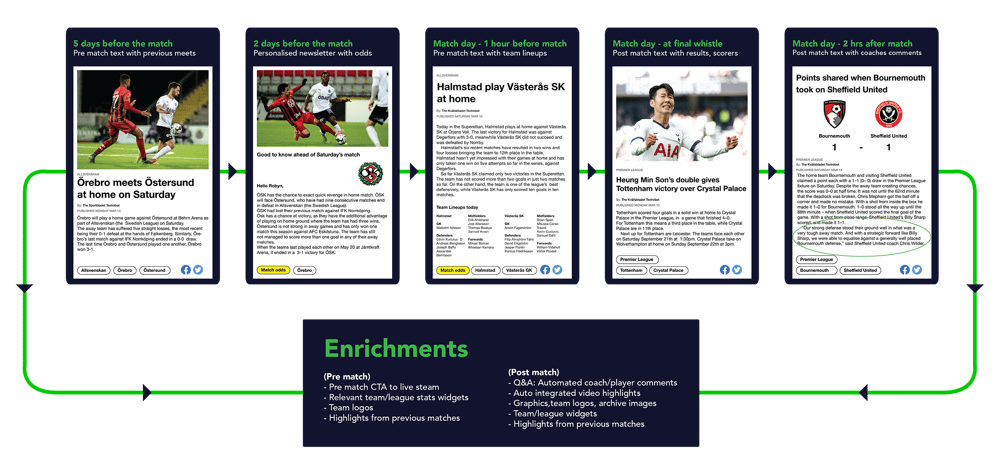Why volume is the real star of news automation

For the publishers we work with, there is one aspect of automated content that really stands out. One key value they leverage – namely the volume of texts the robots can produce. Time and again we see it. Media companies discovering the real benefit of news automation when they start using it to provide coverage where there previously was none. For sports e g, it means you can set up a publishing timeline (see image) for every league, every match, every reader – all generated automatically.
Robots have no real issues with scale – one article takes as long to write as 100. This means the robot can write about all divisions of all sports or fill in news deserts in the local reporting map with stories of company registrations and house sales – coverage which would be too resource intensive to have reporters produce. And suddenly there’s reader engagement and revenue and even ad impressions without any impact to newsroom resources.
Content automation drives a lot of different effects for the newsroom and the publishing business. But at the heart of the value of news automation is the volume of content it delivers. Because from the volume flow multiple opportunities, including:
Offer comprehensive coverage of e g sports. With a sports robot publishers can report on all matches in all leagues of all local sports, allowing them to reach many more local communities and individuals with their sports journalism. This drives both reach and engagement.
 Swedish sports publisher EverySport Media Group publish a number of sport specific sites in Sweden, Finland, with further countries to come. ESMG publishes automated match reports, in football, ice hockey and floorball, and the robot texts mean the group is cost effectively able to cover all leagues including junior leagues. Says CEO Hannes Andersson (pictured): “Our strategy is to offer comprehensive coverage. We believe publishing thousands of articles with a dozen or so views each, generates value in a couple of ways. Firstly it’s about reach, which is the foundation of our current business model. Local sports articles often go viral in small clusters which means we reach big audiences on hyper local level. It’s also important for our brand to be seen to provide coverage of all leagues and divisions, including junior ones.”
Swedish sports publisher EverySport Media Group publish a number of sport specific sites in Sweden, Finland, with further countries to come. ESMG publishes automated match reports, in football, ice hockey and floorball, and the robot texts mean the group is cost effectively able to cover all leagues including junior leagues. Says CEO Hannes Andersson (pictured): “Our strategy is to offer comprehensive coverage. We believe publishing thousands of articles with a dozen or so views each, generates value in a couple of ways. Firstly it’s about reach, which is the foundation of our current business model. Local sports articles often go viral in small clusters which means we reach big audiences on hyper local level. It’s also important for our brand to be seen to provide coverage of all leagues and divisions, including junior ones.”
Automation doesn’t just allow a publisher to distribute big numbers of match reports at the final whistle. With automated sports content it’s possible to engage readers in different ways before, during and after match day. So a publisher could have a publishing timeline for every league, every match, every reader – all generated automatically (see illustration).
Meet reader demand for more stories. Or do what Norwegian publisher Bergens Tidende has done; produce content the readers didn’t even know they needed – and generate new demand. Automation has enabled BT to create a Homes Sales section on the Bergens Tidende site, populated solely with automated articles about property sales. Without automation, the Boligsalg section would not have been viable – the newsroom resources required would outstrip the value of the content. As it is, the value produced – combined with neighbourhood level geotargeting – is high enough to drive subscription sales. Says BT Project Lead Jan Stian Vold: “The high quality of this real estate content, combined with the fact that it’s automatically generated, provides a net value for us – and our readers.” By February 2021, 5% of all BT article conversions happen from the automated real estate content.
Populate new sites with stories (and ad inventory). Robot content makes new ventures less risky. Whether you’re setting up a new local site or sports vertical – with robot texts as the bulk, there’s always new content, generating engagement and pageviews. For top Swedish breaking news site Aftonbladet (Schibsted), robot texts are the content foundation for their 230 local destination sites around the country, launched in 2019. From having been fairly Stockholm centric, the local initiative strategy was to get closer to readers in other geographies, as well as generate more local ad revenue. All the destinations publish robot written texts on traffic, weather and local sports. The automated content means the local sites always feel updated.
Thanks to the volumes enabled by news automation, publishers have an opportunity to fill in gaps in the coverage, reach more communities and individuals, and set up new sites – all with no significant impact to newsroom resources.
Lear more about news automation: Download our Whitepaper
